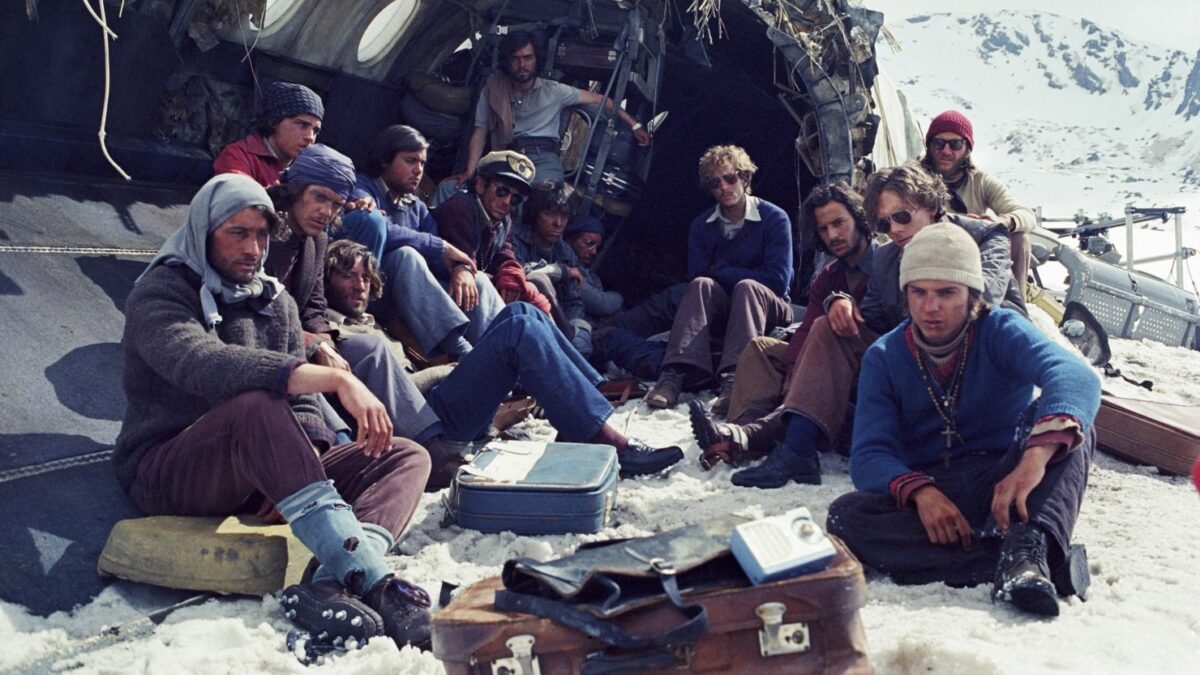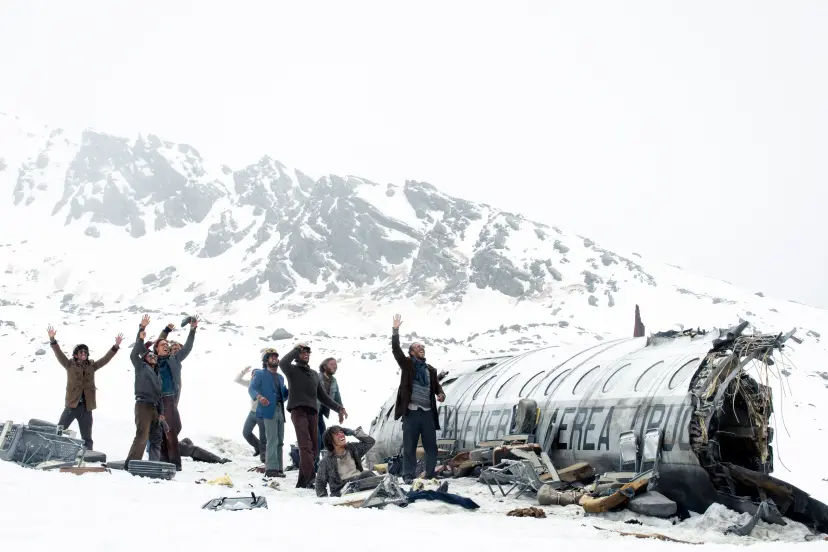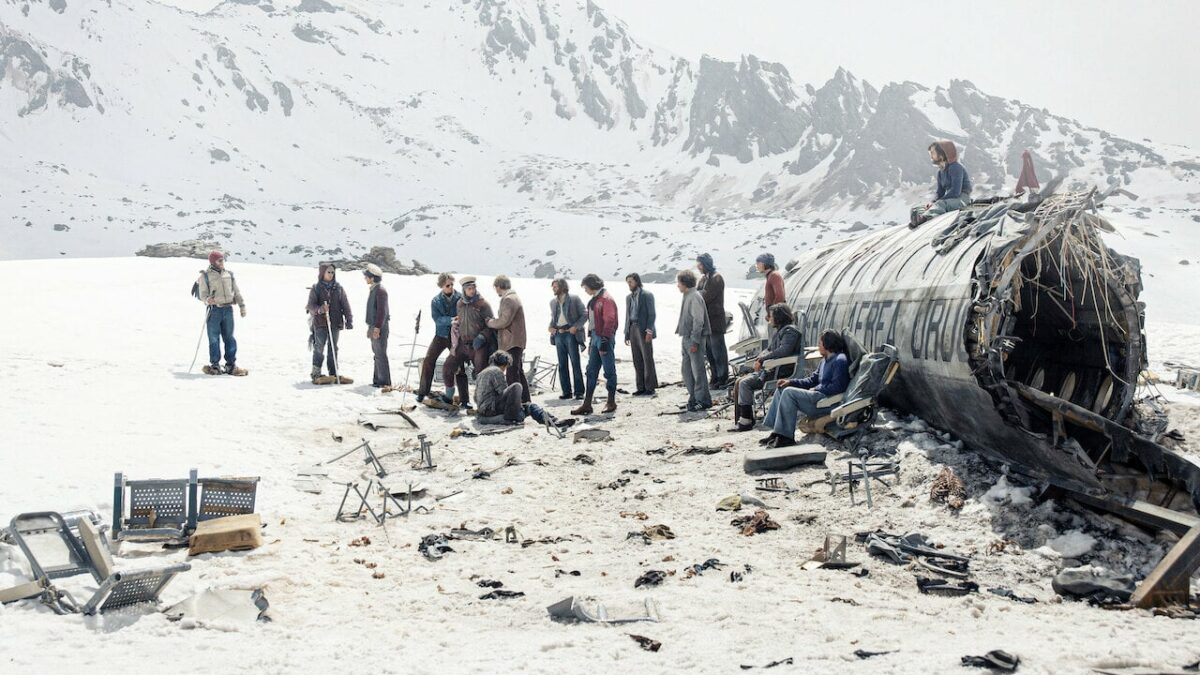The captivating trope of plane crash survivors pitted against the wilderness has long dominated our screens, portraying the grim realities of humanity’s darker impulses. However, ‘Society of the Snow,’ now available on Netflix, takes a distinctive narrative route. Directed by J.A. Bayona (‘The Impossible,’ ‘Jurassic World: Fallen Kingdom’), it unveils the true account of 16 individuals from a Uruguayan rugby team, depicting not descent but unity in the face of unimaginable challenges.
Triumph Amidst Adversity: A Tale of Resilience
Amidst the harrowing portrayal of the 1972 crash of Uruguayan Air Force Flight 571, ‘Society of the Snow’ transcends as a poignant testament to human resilience. It chronicles the 72-day ordeal of survival against starvation, freezing temperatures, and relentless weather turmoil while stranded on an unforgiving Andean glacier.
A Survivor’s Perspective: Transformation in the Face of Crisis
Roberto Canessa, portrayed by Matías Recalt in the film, reflects on the profound impact of Bayona’s storytelling prowess. Having consulted on the movie’s creation, Canessa emphasizes its significance beyond mere entertainment. He highlights the transformative potential within individuals faced with crises, stressing the evolution from athlete to survivor as a testament to human resilience.
Authenticity and Novelty: Breathing Life into a Remarkable Tale
‘Society of the Snow,’ adapted from Pablo Vierci’s book, sets itself apart by capturing the essence of the real crash site. Notably, this rendition marks the first instance where survivors and families allowed their actual names to be used, infusing an unparalleled authenticity into the narrative.
Unveiling the Heart of the Story: Redefining Survival Narratives
Director Bayona underlines the underlying essence of choice and perseverance, emphasizing the critical message of resilience and purpose when faced with dire circumstances. The film, Spain’s Oscar entry, marks Bayona’s return to Spanish cinema since his acclaimed 2007 film ‘The Orphanage.’
How did the plane crash?

It was October 12, 1972, when Uruguayan Air Force Flight 571 embarked from Montevideo, carrying 45 souls—40 passengers, including the Old Christians Club amateur rugby team, and five crew members. Their destination: Santiago, Chile, for an exhibition match that would soon turn into a chilling tale of survival.
A Series of Unfortunate Events
Forced to make an unexpected stop in Mendoza, Argentina, due to adverse weather conditions, the flight was slated to resume on October 13. The plan was to circumvent the treacherous Andes via a lower mountain pass. However, miscalculations altered fate’s course. An hour into the flight, the pilot, guided by air traffic control clearance, initiated descent prematurely, only to collide with an Andean ridgeline.
The impact was catastrophic, rending the plane of its wings and tail. Hurtling down the mountainside, the aircraft finally settled in a valley, perched at an alarming altitude of approximately 11,500 feet.
A Brush with Death: Survivors’ Ordeal
Roberto Canessa’s firsthand account of the crash paints a picture of sheer horror. “You’re dead. You are going to know what is in the last frontier of life,” he recollects, as the plane careened out of control. The sheer velocity of the slide left him grappling with the surreal, disbelief cloaking his survival.
Surveying the wreckage amid the desolate mountainscape, Canessa’s mind struggled to grapple with the surreal. There was an eerie sensation, akin to being ensnared in a perpetual nightmare. “I will wake up. There’s a button I am meant to push, and everything will be over,” he hoped, yet stark reality refused any escape.
What happened to the surviving passengers?

The initial crash dealt a fatal blow, claiming 12 lives and leaving several of the 33 survivors wounded. The grueling first night claimed five more lives, followed by another tragic loss a week later, dwindling their number to 27. Hope flickered amidst frigid nights as makeshift shelter and scant provisions salvaged from luggage sustained them momentarily, only to exhaust within a week.
A Grim Realization: Hope Amidst Despair
Hovering rescue planes offered fleeting hope, yet failed to spot the white wreckage against the snow-covered terrain. The survivors’ hopes plummeted on learning that the search had been terminated, deeming them lost souls. It was a bizarre paradox—living while the world deemed them deceased.
The Harrowing Decision: Survival at Any Cost
As starvation loomed, desperation took hold. Forced into an agonizing dilemma, the survivors, grappling with the harsh reality of their circumstances, resorted to an unthinkable act—cannibalism. Roberto Canessa, the agonized soul amid this turmoil, faced the moral precipice, driven by a deeply personal resolve to reunite with his mother.
Sacrifice in the Face of Struggle
The act of consuming the deceased was an indescribable ordeal, shattering dignity and resilience. However, a resolute determination fueled their macabre sustenance. For Canessa, it was a testament to the unstoppable force of purpose—a reason to persist, rooted in a mother’s potential grief.
Humanizing the Horror: The Film’s Approach
Director Bayona’s vision shunned sensationalism, focusing on the altruistic aspect rather than exploiting the grotesque. The narrative pivoted towards the intrinsic human values—friendship, camaraderie, and unyielding generosity amidst dire straits.
Further Trials and Tragedy
Trapped by avalanches that claimed eight lives and imprisoned the rest, the survivors, resilient but besieged, found sustenance in the unthinkable. Their persistence, buoyed by a shared sense of humor, proved a lifeline amid despair.
A Journey to Survival: Overcoming the Unimaginable
Emerging from the snowbound fuselage only to face further adversity, the group dwindled to 16 survivors after enduring a relentless barrage of trials. Yet, their unwavering resolve sustained them through blizzards and perilous conditions.
How were the survivors rescued?

As temperatures soared, three determined souls—Canessa, Fernando “Nando” Parrado, and Antonio “Tintin” Vizintín—embarked on an audacious quest to breach the mountains and reach civilization in Chile. Canessa’s selfless resolve compelled him to confront the daunting challenge head-on, relinquishing the perceived safety of the fuselage for a heroic journey.
A Journey of Courage: Struggles and Unity
With Vizintín’s return to camp, Canessa and Parrado braved the desolate terrain. Their bond became a lifeline, two souls interwoven into one, enduring the biting cold as they inched closer to the valleys of Chile, step by relentless step.
The Perilous Trek: A Test of Resilience
Ten brutal days amidst treacherous conditions tested their mettle. The encounter with a lone horseback rider became their beacon of hope, signaling the imminent rescue of their stranded comrades.
Sacrifice and Closure: A Heart-Wrenching Farewell
Upon safety’s threshold, Canessa’s poignant act of burying the remains they once consumed for survival—a gesture transcending the macabre sustenance—marked a symbolic closure to their harrowing ordeal.
The Long-Awaited Rescue: Triumph Against Nature’s Wrath
Rescue helicopters descended on the crash site, offering a glimmer of salvation. Yet, the unpredictable elements thwarted a complete airlift, leaving a fragment of survivors behind, eventually rescued the following day.
From Survivor to Savior: A Journey Beyond the Mountains
For Canessa, the transition from enduring the burden of survival to practicing medicine mirrored his unwavering commitment. Freed from the weight of those 72 days, his resilience led him back to medicine, becoming a beacon of hope and healing.

